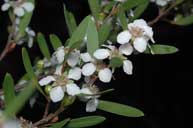In Flower This Week
A news sheet prepared by a Gardens' volunteer.
Numbers before each plant refer to temporary IFTW labels in the gardens.
Numbers in square brackets [ ] refer to garden bed Sections. Plants in flower are in bold type.
View past issues of 'In Flower This Week'.
24 December 2014
Leptospermum subglabratum click for larger image |
Take a shaded walk from the Visitors Information Centre (VIC) up the hill behind the café to see some festive flowers.
- On the left across from the VIC is Rhododendron viriosum [Section 212], with magnificent coral bell flowers and shiny dark green leaves. This is one of the few representatives of this genus in Australia and is found in the high mountains of tropical northern Queensland.
- On your right in a pot is Blandfordia grandiflora [Section 221], or Christmas Bells,with large fluted red bell flowers tipped with yellow on thin stems above linear foliage. It is native to south-eastern Australia.
- Further along on your right in a pot is Swainsona formosa [Section 221] or Sturt’s Desert Pea with pale grey-green leaves and bright red pea flowers with shiny black centres or bosses. This iconic plant is named after English botanist Isaac Swainson.
- On your right are several small trees of Banksia serrata [Section 174] or Saw Banksia behind the sculpture of Sir Joseph Banks. They have chunky greenish cones and ovate leaves with toothed margins.
- Scaevola albida [Section 174] also on your right is a prostrate shrub native to southern Australia. It has mauve fan flowers on light green foliage.
- In a pot on your left is Anigozanthos ‘Bush Sunset’ [Section 210] with vibrant red Kangaroo Paw flowers on long stems.
- Grevillea juncifolia [Section 210] on your left in a pot has with narrow grey bootlace leaves and long sprays of yellowish-white flowers. This grevillea grows in dry inland Australia.
- Bear left up the hill behind the café. Look up to see on your left Clerodendrum floribundum var. attenuatum [Section 125] or Lolly Bush, a small rainforest tree in full bloom with clusters of strongly scented white bell flowers against dark green foliage.
- In a bed on your right is a dense groundcover, Grevillea ‘Poorinda Royal Mantle’ [Section 124], with masses of red toothbrush-like flowers that are a beacon for both birds and bees.
- Further on your left is Hibiscus divaricatus [Section 114] with pure yellow flowers contrasting with maroon stamens on a straggly bush. This hibiscus is found in coastal areas of Queensland. It is usually a shrub, but can reach the size of a small tree, up to about five metres tall.
- Also on the left, Hibiscus heterophyllus subsp. heterophyllus [Section 114] has many startlingly white flowers with deep red centres. This plant can be a tall shrub or small tree and is native to coastal New South Wales and Queensland.
- On the right is a bed filled with Kangaroo Paws, Anigozanthos flavidus [Section 17], in rusty orange and green shades. All kangaroo paws are native to Western Australia, but many are now cultivated worldwide. Their flowers are bird-pollinated.
- On the left is a hybrid involving Hibiscus splendens [Section 114], with lolly-pink blooms with deeper-coloured throats. The foliage is coarse and furry to the touch.
- Leptospermum subglabratum [Section 17], on the right, has masses of white tea-tree flowers on a weeping bush with small foliage. This plant grows in the wild in shallow rocky soil of sandstone escarpments of the Budawang Ranges and adjacent ranges of New South Wales.
- Acmena smithii [Section 140], on your left, is a small tree with a dense crown of shiny green leaves covered in clusters of cream flowers. This is the best known member of the lilly-pillies and is widespread in east coast rainforests from north Queensland to Victoria. It has also been introduced to King Island in Bass Strait.
Rosalind Walcott
![Director of National Parks [logo]](../../../../images/dnp_90px.gif)







